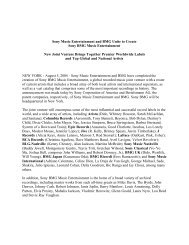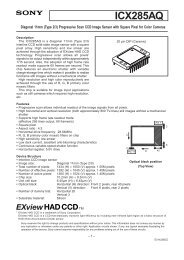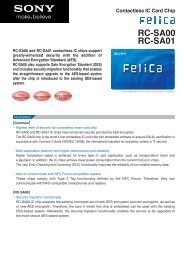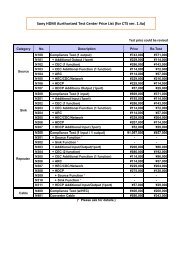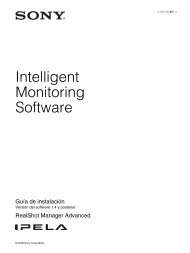PDF [4833KB] - Sony
PDF [4833KB] - Sony
PDF [4833KB] - Sony
You also want an ePaper? Increase the reach of your titles
YUMPU automatically turns print PDFs into web optimized ePapers that Google loves.
Promoting a worldwide EMCS structure: Overhauling engineering and manufacturing<br />
frameworks to reflect distinctive regional needs on a global scale<br />
Rethinking global engineering, manufacturing,<br />
distribution and service functions<br />
As part of “Transformation 60,” <strong>Sony</strong> is busy<br />
reshaping its product creation structure into a<br />
more knowledge-intensive model. For its worldwide<br />
operations, <strong>Sony</strong> has introduced a new<br />
engineering and production platform called EMCS<br />
(representing engineering, manufacturing and<br />
customer services). From the ground up, <strong>Sony</strong> is<br />
completing a comprehensive review of its production<br />
network, which had been structured to manufacture<br />
products within each region. The intent is<br />
to overhaul the engineering and manufacturing<br />
frameworks to better reflect the distinct features of<br />
each region, and simultaneously increase the added<br />
value generated by these frameworks. Maximizing<br />
the integration of global functions from engineering<br />
through manufacturing, distribution and customer<br />
service will foster an environment for the<br />
global implementation of an advanced supply<br />
chain management (SCM) system. <strong>Sony</strong> plans to<br />
convert some of its manufacturing facilities into<br />
Customer Front Centers (CFC). By improving distribution<br />
and service capabilities, these centers will<br />
enable <strong>Sony</strong> to further upgrade various customer<br />
services and respond even more efficiently to<br />
consumer needs.<br />
<strong>Sony</strong> seeks to reinforce its engineering framework<br />
and refine its ability to manufacture value-added<br />
components, such as semiconductors, in turn<br />
enhancing its mounting processes and helping to<br />
create new state-of-the-art products. Producing a<br />
steady flow of new products that use leadingedge<br />
components, hence giving them a distinctly<br />
<strong>Sony</strong> feel, will be central to the future of <strong>Sony</strong>’s<br />
electronics business.<br />
Regional production strategies that mirror<br />
market needs<br />
<strong>Sony</strong>’s strategy for its global production bases is<br />
to deepen ties between manufacturing activities<br />
in Japan, China and elsewhere in Asia. <strong>Sony</strong> is<br />
increasing production of finished goods in China in<br />
anticipation of continued rapid growth in demand,<br />
Production Locations and Destinations of Electronics Products<br />
Europe<br />
China<br />
SE Asia<br />
as well as increasing the output of both costcompetitive,<br />
mass-produced products for export<br />
and components and modules associated with<br />
operations in Japan. Products that are manufactured<br />
price-competitively in other parts of Asia<br />
are exported to Japan, Europe and the U.S. as well<br />
as supplied within the region itself. To enhance<br />
responsiveness to customer needs in each<br />
region, CFC functions are also being added to<br />
Asian manufacturing sites. In Europe and the<br />
U.S., two of <strong>Sony</strong>’s major markets, the current<br />
single-category mass-production framework will<br />
be complemented by adding CFC functions, thus<br />
enabling a faster response to market needs<br />
while strengthening manufacturing and sales<br />
activities within each region.<br />
Japan <br />
North<br />
America<br />
Raising Japan’s profile as a source of advanced<br />
technology<br />
Through the creation of its new EMCS-based<br />
structure, <strong>Sony</strong> has made Japan a focal point for<br />
sophisticated technology. By forming close ties<br />
between its development and engineering teams,<br />
Production<br />
Destination<br />
*Size of circle represents scale of production<br />
■ Japan<br />
■ North America<br />
■ Europe<br />
■ SE Asia<br />
■ China<br />
A new information system that integrates sales, manufacturing and distribution<br />
• Prepares highly accurate sales forecasts based on actual results through collaboration<br />
with distribution operations<br />
• Performs real-time monitoring of retail sales and inventories and uses this data to<br />
create an optimal manufacturing and supply system<br />
• Provides highly accurate responses to inquiries for delivery times by combining manufacturer<br />
inventory data with manufacturing plans<br />
• Constructs a logistics system that minimizes manufacturer inventories<br />
• Expands the scope of weekly management operations to increase responsiveness to<br />
rapid shifts in sales trends and other events<br />
Utilizing demand chain management to create a product supply framework that<br />
responds immediately to sales data<br />
CLOVER comes into operation: A new information system supporting the integration<br />
of sales, manufacturing and distribution operations<br />
Retail stores<br />
SMOJ<br />
SONY<br />
Corp.<br />
SSCS<br />
EMCS<br />
Components suppliers<br />
Overseas manufacturing sites and suppliers<br />
The new CLOVER information system began operating in May 2004. Adopted by <strong>Sony</strong> Corporation, <strong>Sony</strong><br />
Marketing (Japan) Inc. (SMOJ), <strong>Sony</strong> EMCS Corporation (EMCS) and <strong>Sony</strong> Supply Chain Solutions, Inc.<br />
(SSCS), the new system integrates sales, manufacturing and distribution operations to give <strong>Sony</strong> a competitive<br />
edge in Japan. CLOVER provides sophisticated data links between individual operations, facilitating<br />
demand chain management with the aim of creating an enhanced flexible product supply system that<br />
responds immediately to changes in actual retail sales data. Key benefits are greater customer satisfaction,<br />
minimal loss of sales opportunities, and lower inventories at manufacturing sites and in distribution<br />
channels. <strong>Sony</strong> expects CLOVER to produce cost savings and inventory reductions in Japan.<br />
Information<br />
Products<br />
29


![PDF [4833KB] - Sony](https://img.yumpu.com/26420643/31/500x640/pdf-4833kb-sony.jpg)








